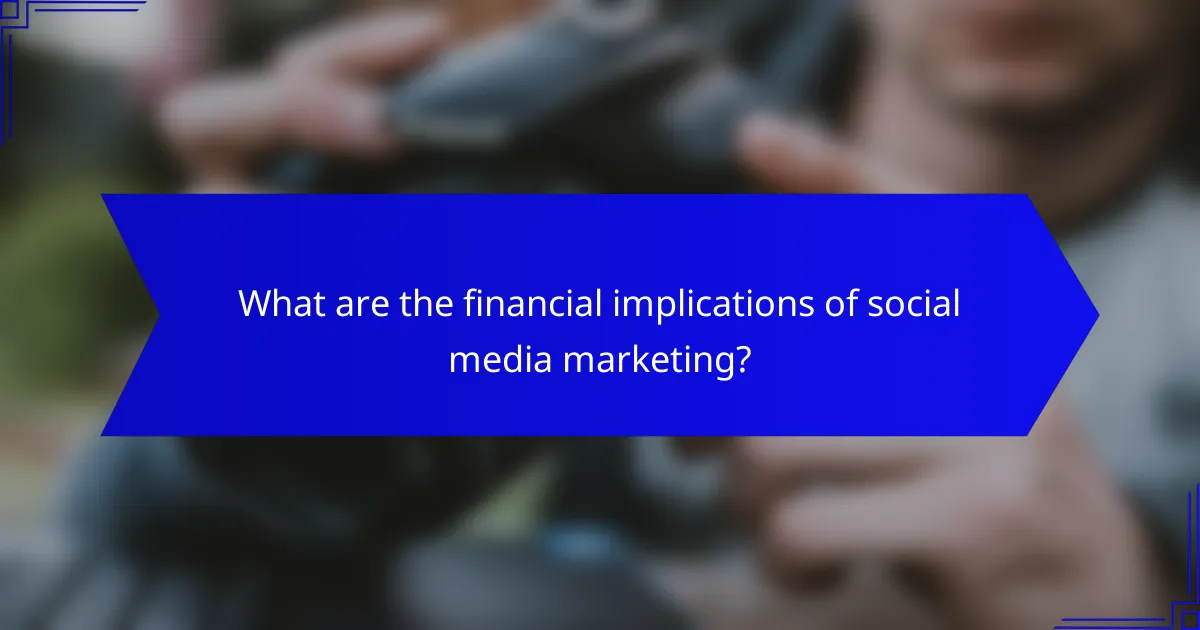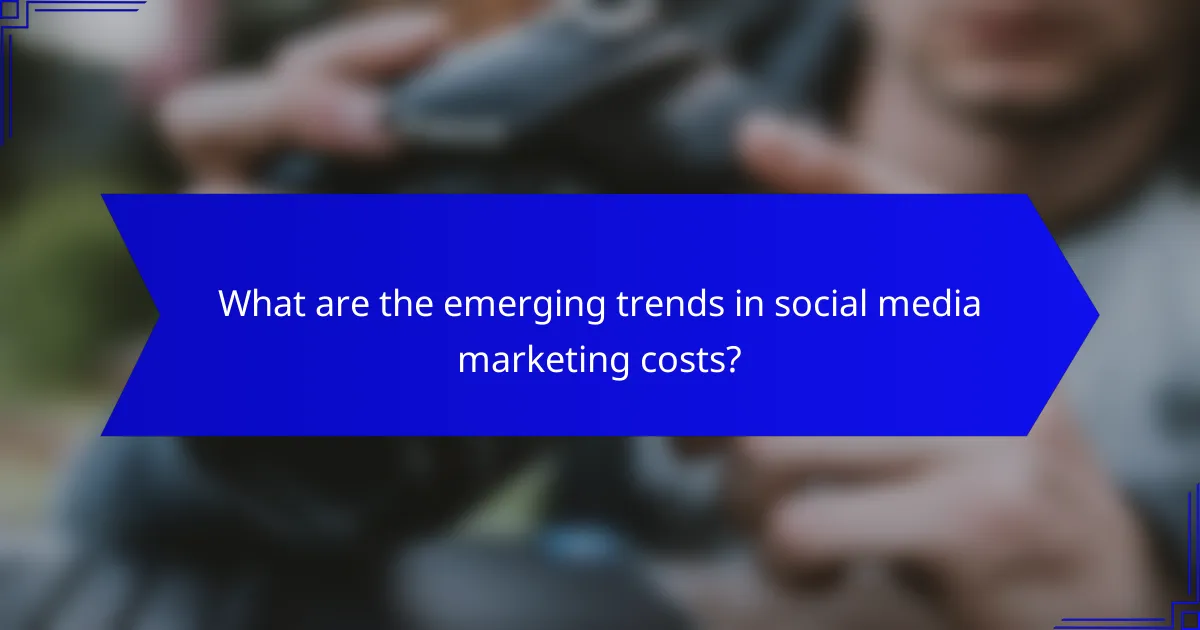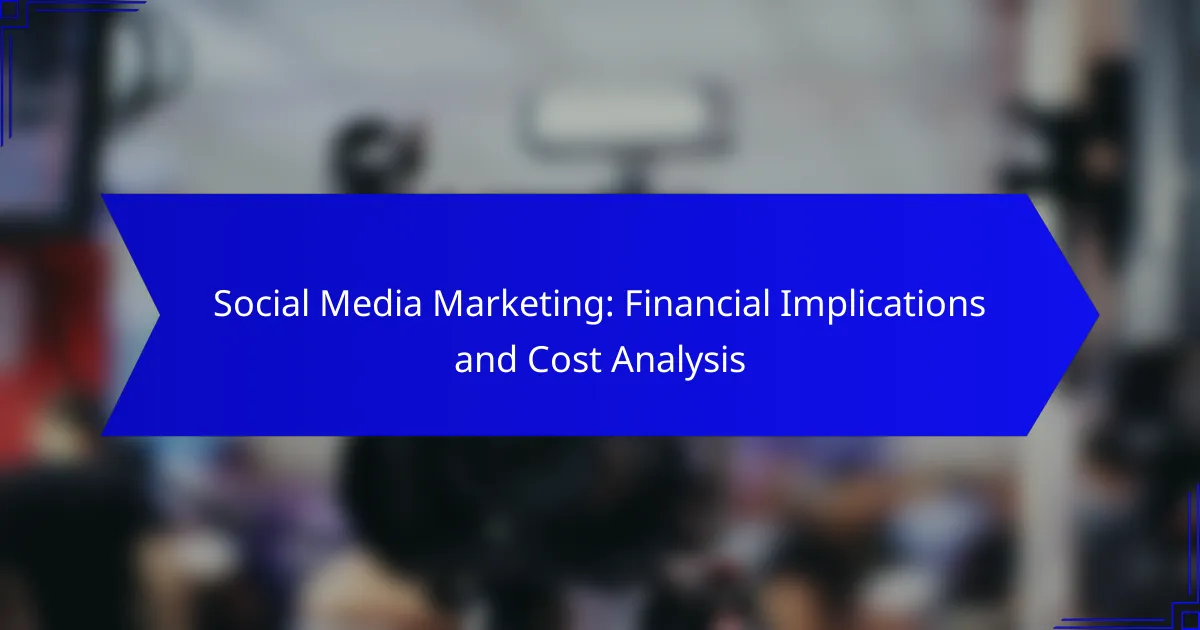Social media marketing presents a range of financial implications that businesses must navigate, including various costs and potential returns. By implementing effective strategies, companies can enhance brand visibility and customer engagement, which can significantly influence profitability. The costs associated with social media marketing can vary widely based on location, competition, and target audience, requiring careful analysis and planning. Key metrics such as cost per engagement and customer lifetime value are essential for assessing the financial impact of these marketing efforts.

What are the financial implications of social media marketing?
The financial implications of social media marketing include various costs and potential returns that businesses must consider. Effective social media strategies can lead to increased brand visibility and customer engagement, ultimately impacting overall profitability.
Increased brand awareness
Investing in social media marketing can significantly enhance brand awareness. By consistently sharing engaging content, businesses can reach a broader audience, which may lead to higher visibility in their respective markets.
For example, companies often see a notable uptick in followers and engagement rates after launching targeted ad campaigns. This increased awareness can translate into more website traffic and potential sales, making it a crucial aspect of financial planning.
Customer acquisition costs
Social media marketing can influence customer acquisition costs (CAC), which are the expenses incurred to gain new customers. These costs can vary widely depending on the platform used and the effectiveness of the marketing strategy.
Typically, CAC can range from low tens of dollars to several hundred dollars, depending on the industry. Businesses should analyze their spending on ads and promotions against the number of new customers gained to ensure they are achieving a sustainable CAC.
Return on investment (ROI)
Calculating the return on investment (ROI) for social media marketing is essential for understanding its financial impact. A positive ROI indicates that the revenue generated from social media efforts exceeds the costs involved.
To calculate ROI, businesses can use the formula: (Net Profit / Cost of Investment) x 100. Aiming for an ROI of at least 100% is a common benchmark, but many successful campaigns achieve much higher returns, particularly when leveraging organic reach alongside paid advertising.
Long-term customer loyalty
Social media marketing can foster long-term customer loyalty, which is vital for sustained financial success. Engaging with customers through social media helps build relationships and trust, encouraging repeat business.
Brands that actively respond to customer inquiries and feedback often see higher retention rates. Investing in loyalty programs and exclusive social media promotions can further enhance customer loyalty, leading to increased lifetime value and reduced churn rates.

How much does social media marketing cost in major US cities?
The cost of social media marketing varies significantly across major US cities, influenced by factors such as competition, target audience, and platform choice. Businesses can expect to allocate anywhere from a few hundred to several thousand dollars monthly, depending on their specific strategies and goals.
Cost per click (CPC) in New York
In New York, the average cost per click (CPC) for social media advertising can range from $1 to $5, depending on the platform and industry. High competition in sectors like fashion and finance may push CPCs to the upper end of this range.
To optimize CPC, businesses should focus on targeting specific demographics and using engaging ad content. Regularly analyzing performance metrics can help refine strategies and reduce costs over time.
Monthly advertising budgets in Los Angeles
Monthly advertising budgets for social media marketing in Los Angeles typically range from $500 to $10,000, influenced by the size of the business and campaign objectives. Smaller businesses may start with a budget of $500 to $1,500, while larger brands often invest significantly more to reach broader audiences.
It’s essential to set clear goals and measure return on investment (ROI) to ensure that advertising spend aligns with business growth. Businesses should consider testing different budget levels to find the most effective allocation for their campaigns.
Average influencer marketing fees in Chicago
In Chicago, influencer marketing fees can vary widely, with micro-influencers charging around $100 to $1,000 per post, while more established influencers may demand $1,000 to $10,000 or more. The choice of influencer should align with the brand’s target audience for maximum impact.
When engaging influencers, brands should focus on building authentic relationships and ensuring that the influencer’s values resonate with their own. This approach can lead to more effective campaigns and higher engagement rates.

What are the key metrics for evaluating social media marketing costs?
Key metrics for evaluating social media marketing costs include cost per engagement (CPE), cost per thousand impressions (CPM), and customer lifetime value (CLV). Understanding these metrics helps businesses assess the effectiveness and financial impact of their social media strategies.
Cost per engagement (CPE)
Cost per engagement (CPE) measures the cost incurred for each interaction with your content, such as likes, shares, and comments. This metric is crucial for understanding how effectively your content resonates with your audience.
To calculate CPE, divide your total advertising spend by the number of engagements received. For example, if you spend $500 and receive 1,000 engagements, your CPE would be $0.50. Aim for a low CPE to maximize your return on investment.
Cost per thousand impressions (CPM)
Cost per thousand impressions (CPM) indicates how much you pay for every 1,000 times your ad is displayed. This metric is essential for evaluating brand visibility and reach on social media platforms.
To compute CPM, divide your total ad spend by the number of impressions (in thousands). For instance, if you spend $1,000 for 200,000 impressions, your CPM would be $5. A lower CPM suggests more efficient ad spending, but consider the quality of impressions as well.
Customer lifetime value (CLV)
Customer lifetime value (CLV) estimates the total revenue a business can expect from a single customer over their entire relationship. This metric is vital for determining how much you can afford to spend on acquiring customers through social media marketing.
To calculate CLV, multiply the average purchase value by the average purchase frequency and the average customer lifespan. For example, if a customer spends $100 per purchase, buys twice a year, and stays for five years, the CLV would be $1,000. Understanding CLV helps in setting appropriate budgets for social media campaigns.

What factors influence social media marketing expenses?
Social media marketing expenses are influenced by various factors including platform selection, target audience demographics, and content type and quality. Understanding these elements can help businesses allocate their budgets more effectively and achieve better returns on investment.
Platform selection
The choice of social media platforms significantly impacts marketing costs. Each platform has its own advertising rates, audience reach, and engagement levels. For instance, advertising on platforms like Facebook and Instagram may require higher budgets compared to LinkedIn, which is often more expensive but targets professionals.
Consider the specific goals of your campaign when selecting a platform. If your aim is brand awareness, platforms with broader user bases might be more beneficial, while niche platforms could be more effective for targeted campaigns. Analyze the costs associated with each platform’s ad formats, such as pay-per-click or cost-per-impression, to make informed decisions.
Target audience demographics
The demographics of your target audience can significantly influence social media marketing costs. Different age groups, genders, and interests may require tailored content and advertising strategies, which can affect overall expenses. For example, targeting a younger demographic on TikTok may involve different costs compared to reaching an older audience on Facebook.
Understanding your audience’s preferences and behaviors helps in crafting effective campaigns. Utilize analytics tools to gather insights about your audience, which can guide budget allocation and campaign strategies. This targeted approach can lead to higher engagement rates and a better return on investment.
Content type and quality
The type and quality of content you produce for social media marketing can greatly affect costs. High-quality visuals, videos, and interactive content typically require more resources and investment than simple text posts. Businesses may need to hire professionals for graphic design or video production, which can increase overall expenses.
Consider the balance between content quality and budget. While investing in high-quality content can enhance engagement, it’s essential to evaluate the potential return. Experimenting with different content types and monitoring their performance can help determine the most cost-effective strategies for your specific audience.

How can businesses optimize social media marketing budgets?
Businesses can optimize social media marketing budgets by strategically allocating resources based on performance metrics and audience engagement. This involves analyzing data to identify the most effective channels and content types, allowing for more informed spending decisions.
Utilizing analytics tools
Analytics tools provide insights into audience behavior, engagement rates, and content performance. By leveraging platforms like Google Analytics or social media insights, businesses can track which posts drive the most traffic and conversions, enabling them to focus their budget on high-performing content.
Consider setting up regular reporting to monitor key performance indicators (KPIs) such as click-through rates and conversion rates. This will help identify trends and adjust strategies accordingly, ensuring that marketing budgets are spent effectively.
Implementing A/B testing
A/B testing allows businesses to compare two versions of a social media post to determine which performs better. By testing different headlines, images, or calls to action, companies can refine their messaging and improve engagement rates.
Start with small-scale tests to minimize costs and gradually scale successful strategies. Aim for a sample size that provides statistically significant results, typically in the low hundreds, to ensure reliable data for decision-making.
Leveraging user-generated content
User-generated content (UGC) can significantly enhance social media marketing efforts while reducing costs. Encouraging customers to share their experiences with products or services not only fosters community but also provides authentic content that resonates with potential buyers.
Consider running campaigns that incentivize customers to create and share content, such as contests or giveaways. This approach can lead to increased brand loyalty and lower content creation costs, as UGC often requires minimal investment compared to professionally produced materials.

What are the emerging trends in social media marketing costs?
Emerging trends in social media marketing costs indicate a shift towards increased investment in video content and influencer partnerships. Brands are allocating more budget towards platforms like TikTok and Instagram Reels, where engagement rates are notably higher.
Increased focus on video content
Video content is becoming a dominant force in social media marketing, with brands recognizing its effectiveness in capturing audience attention. Costs for producing high-quality video can range from a few hundred to several thousand dollars, depending on the complexity and production quality.
To maximize return on investment, businesses should consider creating short, engaging videos tailored to their target audience. Utilizing tools like Canva or Adobe Spark can help streamline the video creation process without breaking the bank.
Rising costs of influencer marketing
Influencer marketing costs are on the rise as brands compete for partnerships with popular social media figures. Micro-influencers may charge anywhere from $100 to $1,000 per post, while larger influencers can demand thousands or even tens of thousands of dollars.
When selecting influencers, consider their engagement rates and audience alignment rather than just follower count. This approach can lead to more effective campaigns and better use of marketing budgets.
Shift towards paid advertising
As organic reach diminishes, many brands are investing more in paid social media advertising. Costs can vary significantly based on the platform, targeting options, and competition, with average costs per click ranging from a few cents to several dollars.
To optimize ad spend, businesses should regularly analyze campaign performance and adjust targeting parameters. A/B testing different ad formats and messages can also help identify the most effective strategies for reaching your audience.
